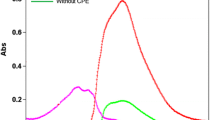Abstract
The aim of this study is the separation and pre-concentration of thorium from aqueous solutions by cloud point extraction (CPE) and its the radiometric determination by liquid scintillation counting (LSC). For CPE, tributyl phosphate (TBP) was used as the complexing agent and (1,1,3,3-Tetramethylbutyl)phenyl-polyethylene glycol (Triton X-114) as the surfactant. The radiometric measurements were performed after phase separation by mixing of the surfactant phase with the liquid scintillation cocktail. The effect of experimental conditions such as pH, ionic strength (e.g. [NaCl]) and the presence of other chemical species (e.g. Ca2+ and Fe3+ ions, and humic acid colloids) on the CPE separation recovery have been investigated at constant reactant ratio (m(TBP)/m(Triton) = 0.1). According to the experimental results the maximum chemical recovery is (60 ± 5)% at pH 3. Regarding the other parameters, generally Ca2+ and Fe3+ ions as well as the presence of colloidal species in solution (even at low concentrations) results in significant decrease of the chemical recovery of uranium. On the other hand increasing NaCl concentration leads to enhancement of chemical recovery. Generally, the method could be applied successfully for the radiometric determination of thorium in water solutions with relatively increased thorium content.






Similar content being viewed by others
References
Gómez EV, Tome FV, Lozano JC, Sanchez AM (1998) Extractive procedure for uranium determination in water samples by liquid scintillation counting. Appl Radiat Isot 49:875–883
Happel S, Letessier P, Ensinger W, Eikenberg JH, Thakkar AH, Horwitz EP (2004) Gross alpha determination in drinking water using a highly specific resin and LSC. Appl Radiat Isot 61:339–344
Vaninbroukx R, Stanef I (1973) Present status in the field of precision liquid scintillation counting. Nucl Instrum Methods 112:111–116
Zikovsky L (2002) Determination of alpha-radioactivity in ground water by precipitation of alpha-emitters with sulphates and hydroxides. J Radioanal Nucl Chem 251:329–331
Antoniou S, Costa C, Pashalidis I (2006) Alpha radiometry of seawater by liquid scintillation counting. J Radioanal Nucl Chem 270:593–596
Antoniou S, Tsiaili A, Pashalidis I (2008) Alpha radiometry of uranium in surface and ground waters by liquid scintillation counting after separation of the radionuclide by cation exchange. Radiat Meas 43:1294–1298
Madrakian T, Afkhami A, Mousavi A (2007) Spectrophotometric determination of trace amounts of uranium(VI) in water samples after mixed micelle-mediated extraction. Talanta 71:610–614
Shemirani F, Kozani R, Reza Jamali M, Assadi Y, Reza Milani S (2005) Micelle-mediated extraction for direct spectrophotometric determination of trace uranium(VI) in water samples. Sep Sci Technol 40:2527–2537
Liang P, Li J, Yang X (2005) Cloud point extraction preconcentration of trace cadmium as 1-phenyl-3-methyl-4-benzoyl-5-pyrazolone complex and determination by flame atomic absorption spectrometry. Microchim Acta 152:47–51
Pashalidis I, Tsertos H (2004) Radiometric determination of uranium in natural waters after enrichment and separation by cation-exchange and extraction techniques. J Radioanal Nucl Chem 260:439–442
Konstantinou E, Pashalidis I, In: Proceedings of 16th radiochemical conference. Uranium determination in water samples by liquid scintillation counting after cloud point extraction. Marianske Lazne, Czech Republic, 18–23 Apr 2010
Texter J (1999) Characterization of surfactants. In: Lange R (ed) Surfactants—a practical handbook. Hanser Gardner Publications Inc., Cincinnati, pp 1–66
Rosen MJ (1989) Characteristics features of surfactants. In: Surface and interfacial phenomena, 2nd edn. Wiley, New York, pp 1–32
El-Kamash AM, El-Sayed AA, Aly HF (2002) Thermodynamics of uranium extraction from nitric acid solution by TBP loaded on inert supporting material. J Radioanal Nucl Chem 253:489–495
Acknowledgments
The research leading to these results has received funding from the Cyprus Research Promotion Foundation (Grant agreement No. ANABATHMISI/PAGIO/0308/04) and the University of Cyprus.
Author information
Authors and Affiliations
Corresponding author
Rights and permissions
About this article
Cite this article
Constantinou, E., Pashalidis, I. Thorium determination in water samples by liquid scintillation counting after its separation by cloud point extraction. J Radioanal Nucl Chem 287, 261–265 (2011). https://doi.org/10.1007/s10967-010-0677-3
Received:
Published:
Issue Date:
DOI: https://doi.org/10.1007/s10967-010-0677-3




